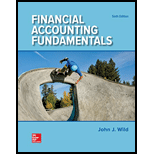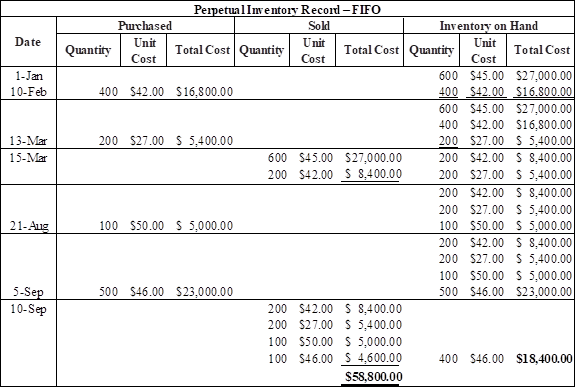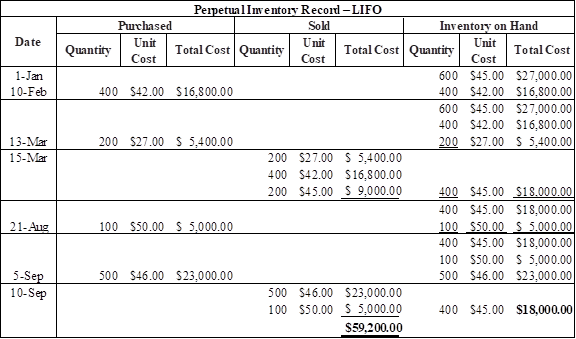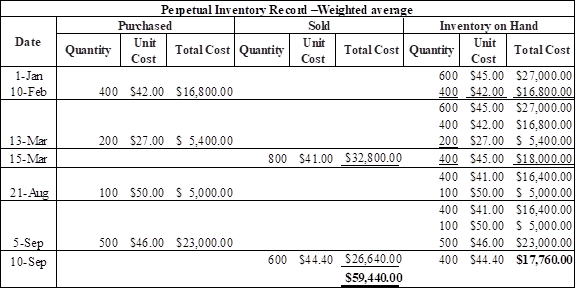
Concept explainers
1.
Ascertain the cost of goods available for sale, and the number of units available for sales.
1.
Explanation of Solution
Ascertain the cost of goods available for sale, and the number of units available for sales as follows:
| Details | Number of Units | Rate per Unit ($) | Total Cost ($) |
| Beginning balance | 600 | 45 | 27,000 |
| Add: Purchases | |||
| February 10 | 400 | 42 | 16,800 |
| March 13 | 200 | 27 | 5,400 |
| August 21 | 100 | 50 | 5,000 |
| September 5 | 500 | 46 | 23,000 |
| Total Goods available for Sale | 1,800 | 77,200 |
Table (1)
Therefore, the number of units available for sales is 1,800 units, and the cost of goods available for sale is $77,200.
2.
Ascertain the number of units in ending inventory.
2.
Explanation of Solution
Ascertain the number of units in ending inventory as follows:
| Details | Number of Units |
| Total Goods available for Sale | 1,800 |
| Less: Sales: | |
| March 15 | 800 |
| September 10 | 600 |
| Ending Inventory | 400 |
Table (2)
Therefore, the number of units in ending inventory is 400.
3.
Ascertain the cost assigned to ending inventory under (a) FIFO, (b) LIFO, (c) weighted average, and (d) specific identification.
3.
Explanation of Solution
Perpetual inventory system: The method or system of maintaining, recording, and adjusting the inventory perpetually throughout the year, is referred to as perpetual inventory system.
First-in-First-Out (FIFO): In this method, items purchased initially are sold first. So, the value of the ending inventory consist the recent cost for the remaining unsold items.
Last-in-First-Out (LIFO): In this method, items purchased recently are sold first. So, the value of the ending inventory consist the initial cost for the remaining unsold items.
Weighted-average Cost Method: In this method, the inventories are priced at the average rate of goods available for sales.
Specific identification method: Specific identification method identifies the cost of each item in ending inventory by separating purchases. In this method, the value of ending inventory is computed based on the lower of cost or market value.
Ascertain the cost assigned to ending inventory under (a) FIFO, (b) LIFO, (c) weighted average, and (d) specific identification as follows:
(a) FIFO

Table (3)
Therefore, the cost of ending inventory under FIFO is $18,400.
(b) LIFO

Table (4)
Therefore, the cost of ending inventory under LIFO is $18,000.
(c) Weighted average method:
Refer working note 1 and 2 for calculation of weighted average cost

Table (5)
Therefore, the cost of ending inventory under weighed average method is $17,760.
Working note:
Calculate the weighted average cost of inventory after March 13purchase
Calculate the weighted average cost of inventory after September 5 purchase
(d) Specific identification method:
| Details | Number of Units | Rate per Unit ($) | Total Cost ($) |
| Cost of goods available for sale (refer table 1) | 77,200 | ||
| Less: Cost of goods sold | |||
| Beginning inventory | 600 | 45 | 27,000 |
| February 10 | 300 | 42 | 12,600 |
| March 13 | 200 | 27 | 5,400 |
| August 21 | 50 | 50 | 2,500 |
| September 5 | 250 | 46 | 11,500 |
| Ending inventory | 18,200 |
Table (6)
Therefore, the cost of ending inventory under specific identification method is $18,200.
4.
Ascertain the gross profit earned by the company for the each of the given methods.
4.
Explanation of Solution
Ascertain the gross profit earned by the company for the each of the given methods as follows:
| Particulars | FIFO | LIFO | Specific Identification | Weighted Average |
| Sales | $ 105,000 | $ 105,000 | $105,000 | $ 105,000 |
| Less: Cost of goods sold | $ 58,800 | $ 59,200 | $ 59,000 | $ 59,440 |
| Gross profit | $ 46,200 | $ 45,800 | $46,000 | $ 45,560 |
Table (7)
5.
Identify the inventory method which is preferred by the manager, if company’s manger earns a bonus based on a percent of gross profit.
5.
Explanation of Solution
Identify the inventory method which is preferred by the manager, if company’s manger earns a bonus based on a percent of gross profit as follows:
In this case, gross profit under FIFO method ($46,200) is more than the other three methods. Hence, the manager of Company would likely to prefer the FIFO method.
Want to see more full solutions like this?
Chapter 5 Solutions
Financial Accounting Fundamentals
- I need help with this financial accounting question using standard accounting techniques.arrow_forwardI am searching for the correct answer to this financial accounting problem with proper accounting rules.arrow_forwardCan you help me solve this financial accounting question using valid financial accounting techniques?arrow_forward
- Sisu, Oliver and Jones are partners. They share profits and losses in the ratios 2/5,2/5 and 1/5 respectively. For the year ended 31 December 19x6 their capital accounts remained fixed at the following amounts Sisu R6000 Oliver R4000 Jones R2000 They have agreed to give each other 10 per cent per annum on their capital accounts. In addition to the above partnership salaries of R3000 for Oliver and R1000 for Jones are to be charged. The net profit of the partnership before taking any of the above into account was R25200. You are required to draw up the appropriation statement of the partnership for the year ended 31 December 19x6arrow_forwardPlease explain the solution to this general accounting problem using the correct accounting principles.arrow_forwardPlease explain the solution to this financial accounting problem using the correct financial principles.arrow_forward

 AccountingAccountingISBN:9781337272094Author:WARREN, Carl S., Reeve, James M., Duchac, Jonathan E.Publisher:Cengage Learning,
AccountingAccountingISBN:9781337272094Author:WARREN, Carl S., Reeve, James M., Duchac, Jonathan E.Publisher:Cengage Learning, Accounting Information SystemsAccountingISBN:9781337619202Author:Hall, James A.Publisher:Cengage Learning,
Accounting Information SystemsAccountingISBN:9781337619202Author:Hall, James A.Publisher:Cengage Learning, Horngren's Cost Accounting: A Managerial Emphasis...AccountingISBN:9780134475585Author:Srikant M. Datar, Madhav V. RajanPublisher:PEARSON
Horngren's Cost Accounting: A Managerial Emphasis...AccountingISBN:9780134475585Author:Srikant M. Datar, Madhav V. RajanPublisher:PEARSON Intermediate AccountingAccountingISBN:9781259722660Author:J. David Spiceland, Mark W. Nelson, Wayne M ThomasPublisher:McGraw-Hill Education
Intermediate AccountingAccountingISBN:9781259722660Author:J. David Spiceland, Mark W. Nelson, Wayne M ThomasPublisher:McGraw-Hill Education Financial and Managerial AccountingAccountingISBN:9781259726705Author:John J Wild, Ken W. Shaw, Barbara Chiappetta Fundamental Accounting PrinciplesPublisher:McGraw-Hill Education
Financial and Managerial AccountingAccountingISBN:9781259726705Author:John J Wild, Ken W. Shaw, Barbara Chiappetta Fundamental Accounting PrinciplesPublisher:McGraw-Hill Education





